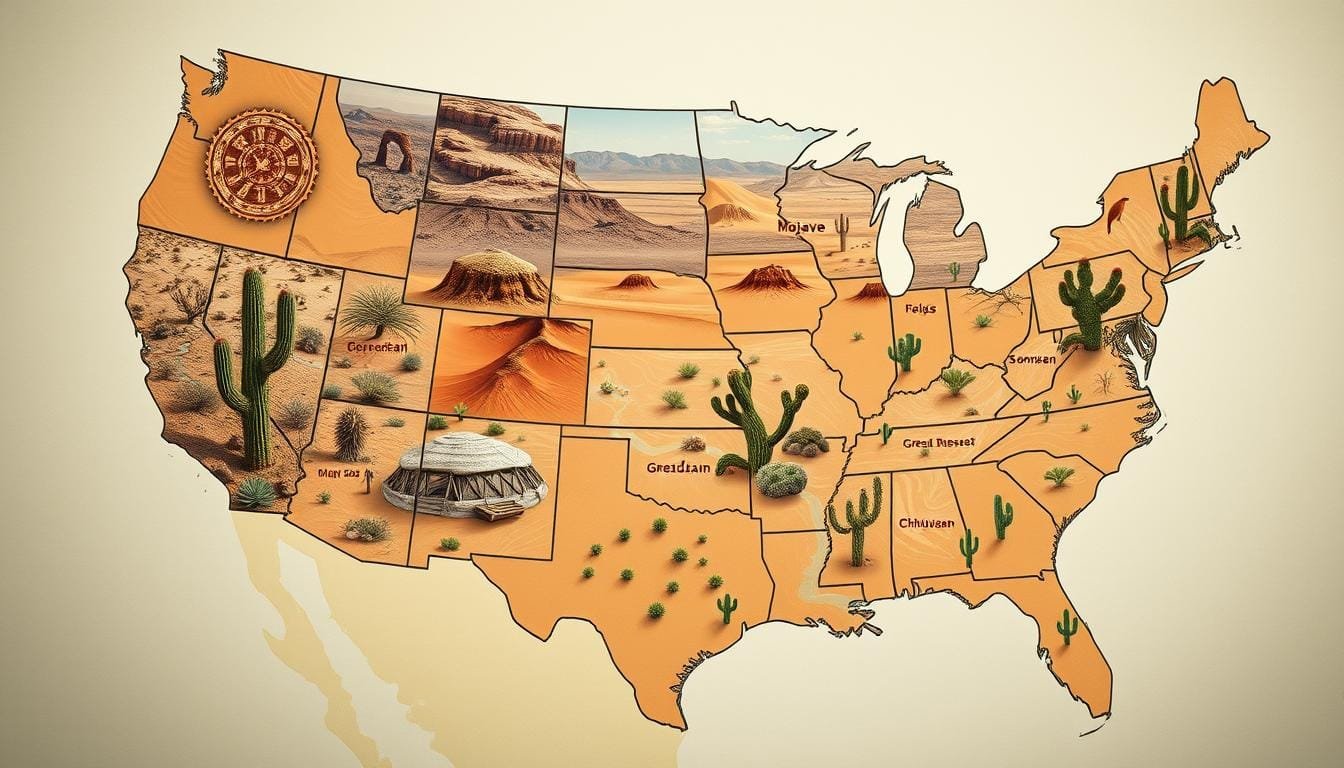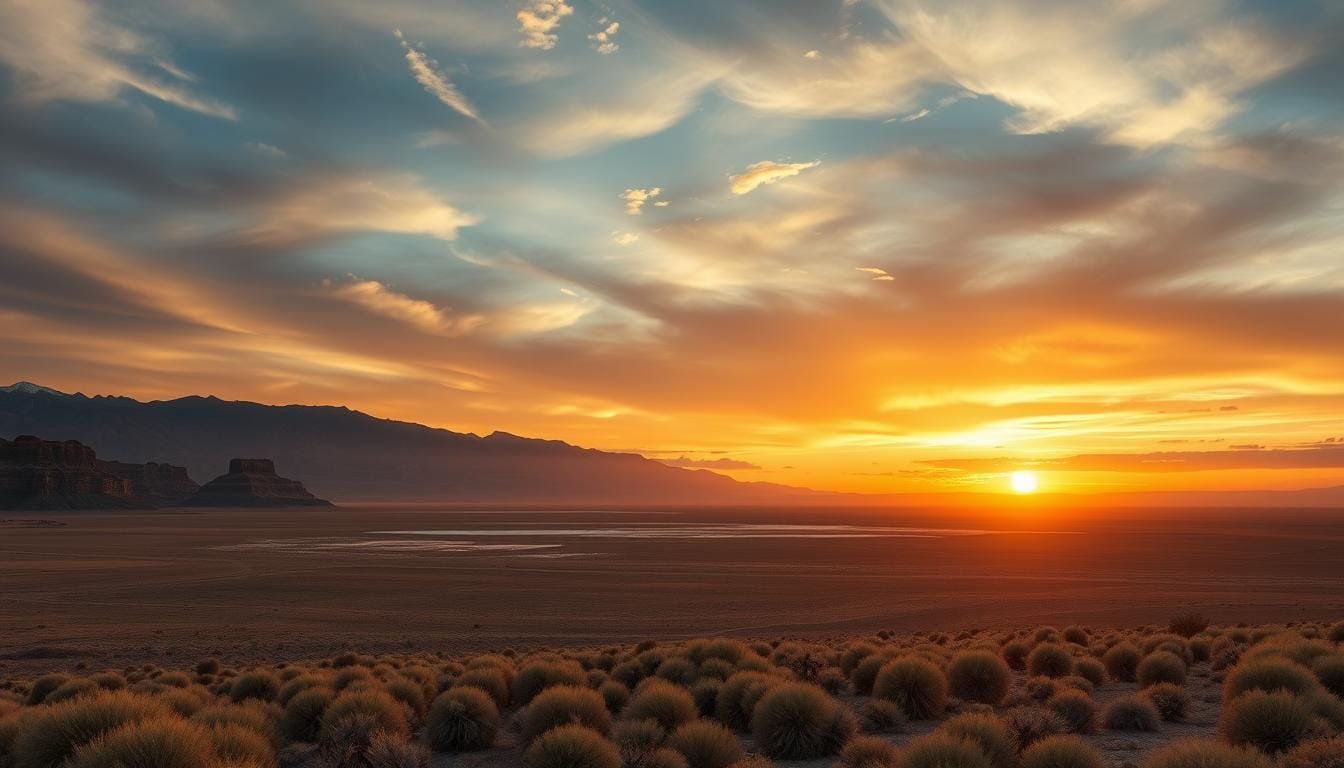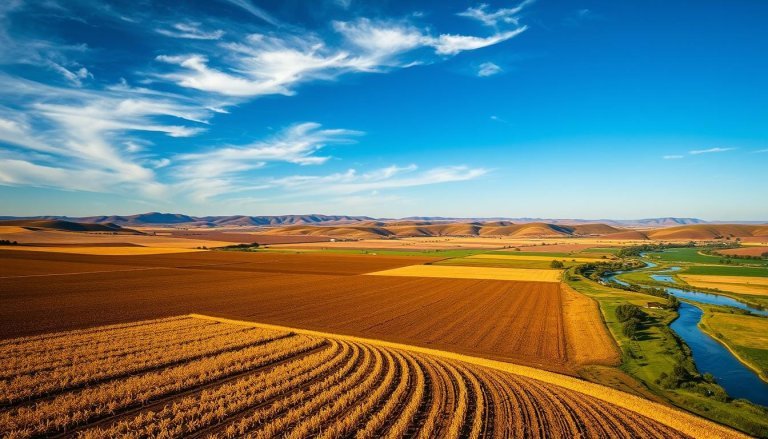The USA has a wide range of landscapes, including big arid areas. These areas are interesting to both visitors and scientists. They cover several states, each with its own special charm and life.
From California to Texas, the USA’s desert areas are huge. The Great Basin Desert is the biggest, covering 190,000 square miles. It has high places that reach about 10,000 feet, with over 600 types of plants and animals.
The Mojave Desert is known for its Joshua trees. It spreads across California, Nevada, and Arizona. Death Valley, the lowest and driest place in North America, is part of it. On the other hand, the Sonoran Desert in Arizona and California is green because of rain all year.
These dry lands are not empty. They are full of life, adapted to harsh conditions. The Sonoran Desert alone has over 300 bird types and 2,000 plant types. This shows how amazing these tough places can be.
Understanding USA Deserts: Location and Overview

The USA has many deserts in the southwestern states. These areas have special plants and animals that live in the dry conditions. Let’s look at the main desert areas and what makes them special.
Major Desert Regions in America
There are four main deserts in America:
- Chihuahuan Desert: Covers 250,000 square miles
- Great Basin Desert: Spans 190,000 square miles
- Mojave Desert: Covers three states
- Sonoran Desert: Includes parts of two states and Mexico
Geographical Distribution of Desert Landscapes
Most USA deserts are in the Southwest. Each area has its own special features:
| Desert | States | Key Features |
|---|---|---|
| Chihuahuan | New Mexico, Texas | Vast expanse, diverse wildlife |
| Great Basin | Nevada, Utah, California, Idaho, Oregon | Cold desert, basin and range topography |
| Mojave | California, Nevada, Arizona | Hottest desert, Joshua trees |
| Sonoran | Arizona, California | Most biodiverse, Saguaro cacti |
Key Characteristics of American Deserts
American deserts have some common traits:
- Low annual rainfall (250-400 mm)
- Extreme temperature changes
- Special plants
- Animals that live in dry places
- Unique rock formations
These deserts face problems like air pollution and water shortage. It’s important to protect these areas and their plants and animals for the future.
The Great Basin Desert: America’s Largest Cold Desert

The Great Basin Desert is a stunning example of nature’s power. It covers 190,000 square miles, making it the biggest cold desert in America. The Sierra Nevada and Wasatch Mountains surround it, creating a special climate.
Climate and Terrain Features
The Great Basin Desert has cold winters with snow, not rain. It gets between 6 to 12 inches of rain a year. The area has tall mountains, over 9,000 feet high, making it a mix of desert and mountains.
Unique Flora and Fauna
This desert is home to many different plants and animals. Sagebrush grows here, and ancient bristlecone pines are found too. Over 600 species live in this tough place, each one special.
Notable Landmarks and Protected Areas
Great Basin National Park is a highlight of the area. It shows off the desert’s plants and rocks. Visitors can see Lehman Caves and enjoy the darkest skies in the country.
- Rich mineral deposits: Nevada leads in gold, magnesite, and barite production
- Utah excels in beryllium ore extraction
- Population centers: Salt Lake City (Utah) and Reno (Nevada)
The Great Basin Desert is a unique place. It has a tough climate, diverse life, and amazing rocks. It’s a great spot for those who love nature and learning.
The Mojave Desert: Home of Joshua Trees
The Mojave Desert covers parts of California, Nevada, Utah, and Arizona. It’s where the famous Joshua trees live. Joshua Tree National Park is a highlight, showing off these plants’ strength.
The Mojave and Colorado Deserts Biosphere Region (MCDBR) is huge, covering 25 million acres. It goes from Death Valley National Park to the US-Mexico border. This area includes some of North America’s most extreme landscapes.
Joshua trees are most common in California. You can find them in Antelope Valley, Lucerne Valley, and Cima Dome. In Nevada, they’re mainly in the south. Utah has them in the north, and Arizona’s northwestern part also has them.
| State | Key Joshua Tree Locations |
|---|---|
| California | Joshua Tree National Park, Antelope Valley, Lucerne Valley, Cima Dome |
| Nevada | Spring Mountains National Recreation Area, Pahrump Valley |
| Utah | Beaver Dam Wash National Conservation Area |
| Arizona | Hualapai Mountains, Arizona Strip |
The MCDBR works with others to help the desert. They follow the United Nations Sustainable Development Goals. This helps keep the Mojave Desert’s special ecosystem safe for the future.
The Sonoran Desert: America’s Most Biodiverse Desert
The Sonoran Desert is a special place in the United States. It covers about 100,000 square miles in Arizona and California. This desert is full of different plants and animals.
Distinctive Desert Ecosystem
This desert is special because of its unique rain pattern. It has more biodiversity than any other desert in North America. It has over 2,000 plant species, 350 bird species, and 30 native fish species.
Saguaro Cacti and Native Species
The saguaro cactus is a symbol of the American Southwest. It lives in the Sonoran Desert. These big cacti help many animals, like birds and insects.
The desert is home to the Gila monster, the only venomous lizard in the U.S. It also has the kangaroo rat, which can survive without drinking water.
Conservation Areas and National Parks
To keep this ecosystem safe, many areas are protected. Saguaro National Park and Organ Pipe Cactus National Monument are examples. These places help keep the desert beautiful and let visitors see its wonders.
- Saguaro National Park: Showcases the iconic saguaro cactus forests
- Organ Pipe Cactus National Monument: Protects diverse desert flora and fauna
- Sonoran Desert National Monument: Preserves a vast expanse of pristine desert landscape
The Sonoran Desert is important for more than its plants. It’s the only place in the USA where wild jaguars live. This shows why we need to keep working to protect this special desert.
The Chihuahuan Desert: North America’s Largest Desert
The Chihuahuan Desert is the biggest desert in North America. It covers a huge area in the U.S. and Mexico. You can find it in Arizona, New Mexico, Texas, and parts of Mexico.
This desert is between two mountain ranges. It’s at high elevations, which makes its climate special. It’s colder than the Sonoran Desert, especially in winter.
The desert plants are very diverse. Creosote bush and yucca plants are common. The Wallace Desert Garden at Boyce Thompson Arboretum shows off these plants.
Many animals live in the Chihuahuan Desert. Desert bighorn sheep and pronghorn antelope are fast runners. You’ll also see mule deer, grey foxes, jaguars, and rabbits.
It’s important to protect this desert. Conservation helps keep its plants and animals safe. This keeps the desert’s balance in North America.
Exploring USA Deserts: Visitor Information and Activities
The USA’s deserts are full of amazing adventures for nature fans. Places like the Painted Desert and Petrified Forest National Park are breathtaking. They show off stunning views and rich life.
Best Times to Visit Desert Regions
Spring and fall are the best times to go. The weather is mild, great for outdoor fun. The Painted Desert Rim Trail, a 1.2-mile walk, is a must-see. It shows off the area’s colorful rocks.
Desert Hiking and Camping Guidelines
Here are some tips for your desert trip:
- Choose from 6 national parks and monuments for diverse experiences
- Book accommodations early, especially for in-park lodges
- Explore less-visited areas like the Grand Canyon’s North Rim
- Try unique viewpoints like Utah’s Dead Horse Point State Park, 2,000 feet above the Colorado River
Safety Tips for Desert Exploration
Desert camping needs careful planning:
- Carry plenty of water to prevent dehydration
- Use sun protection, including hats and sunscreen
- Stay on marked trails and inform others of your plans
- Practice Leave No Trace principles to preserve fragile ecosystems
- Be aware of wildlife and potential hazards
Remember, safety is key when exploring these awe-inspiring landscapes.
Conclusion
The USA’s deserts are amazing examples of nature’s strength and variety. From the Great Basin to the Sonoran, these dry lands are full of life. They need our help to stay safe from dangers like climate change and cities growing too big.
Wildlife in the deserts, like the Joshua tree and saguaro cactus, are very strong. They show us how life can survive in tough places. We can help keep these special places safe by being careful visitors and spreading the word about their importance.
Exploring America’s deserts has shown us their unique features and importance. These dry areas are not only beautiful but also full of scientific secrets. By supporting conservation and visiting responsibly, we can keep these wonders alive for everyone to see and learn from.



